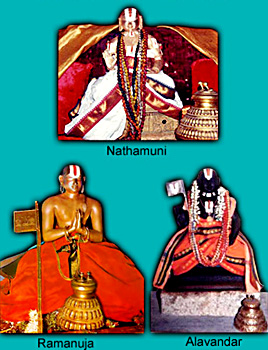 Vaishnavism in the Tamil Hymns of Alvars lies contained in the four thousand Tamil hymns composed by the twelve Vaishnava saints known as Alvars. It marks an important stage of development of Vaishnavism. Alvars were born in different parts of South India long before Ramanuja. The traditional date ascribed to the earliest Alvar is 4203 B.C. and the date of the latest Alvar is 2706 B.C. But modern scholars assign it to the period between the A.D. 200 and A.D. 800. They were great mystics deeply immersed in the divine experience. They have expressed their experience of God and His glory in the form of Tamil verses which are collectively entitled Nalayira Divyaprabandham or four thousand Divine Hymns. These mystic outpourings contain rich philosophical and religious thoughts drawn from the Upanishads, Itihasas and Puranas. They cover all the essential teachings of Vaishnavism and have thus contributed to the further development of Vaishnavism by Nathamuni, Alavandar and Ramanuja, the three principal Vaishnava apostles and by the later Vaishnava acharyas.
Vaishnavism in the Tamil Hymns of Alvars lies contained in the four thousand Tamil hymns composed by the twelve Vaishnava saints known as Alvars. It marks an important stage of development of Vaishnavism. Alvars were born in different parts of South India long before Ramanuja. The traditional date ascribed to the earliest Alvar is 4203 B.C. and the date of the latest Alvar is 2706 B.C. But modern scholars assign it to the period between the A.D. 200 and A.D. 800. They were great mystics deeply immersed in the divine experience. They have expressed their experience of God and His glory in the form of Tamil verses which are collectively entitled Nalayira Divyaprabandham or four thousand Divine Hymns. These mystic outpourings contain rich philosophical and religious thoughts drawn from the Upanishads, Itihasas and Puranas. They cover all the essential teachings of Vaishnavism and have thus contributed to the further development of Vaishnavism by Nathamuni, Alavandar and Ramanuja, the three principal Vaishnava apostles and by the later Vaishnava acharyas.
Of the four thousand hymns contributed by the different Alvar varying in number, 1102 verses of Nammalvar which are called Tiruvaymoli are held in high esteem. They are regarded as Dramida Upanishad or Tamil Veda (Tamil-marai) because these contain the essence of the Upanisadic teachings. Its importance and popularity in the realm of Vaishnavism may be judged by the number of commentaries and sub-commentaries written on these hymns. In fact, some of the Vaishnava acharyas after the 14th century have been so much attracted by the hymns of the Alvars that they have devoted greater attention to the teachings contained in the hymns and the commentaries thereon in Manipravala language in preference to the Vedanta texts in Sanskrit.
The main doctrines expounded in the Tamil hymns are: (i) that Vishnu or Narayana associated with Sri is the paratattva; (ii) Bhakti or prapatti is the means to attain moksa; (iii) kaihkarya or service to God and godly men is an important duty of a true Vaishnava; (iv) moksha or release from bondage is the supreme goal. The three principal tenets of Visistadvaita Vedanta, viz., Tattva, Hita and Purusartha as presented in the Vedanta-sutra, are developed by Nammalvar in the Tiruvaymoli. Ramanuja, though he did not write any commentary on the Tamil hymns, has definitely been influenced by their teachings. Under his direction, the very first commentary known as Ardyirappadi was written by his closest disciple named Pillan. Thus the Vaishnavism expounded by Ramanuja and his followers are based not only on the teachings of the Upanisads, Vedanta-sutra, Bhagavad Gita and the Pancharatra treatises but also on the teachings contained in the Tamil hymns of Alvars. Hence it is designated as ubhayavedanta that is, Vedanta based on Sanskrit Vedanta texts and Tamil works of Alvars.




















